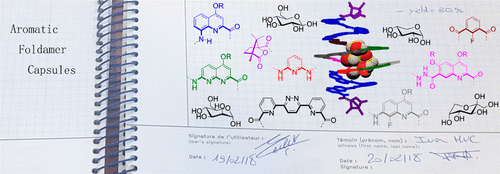当前位置:
X-MOL 学术
›
Acc. Chem. Res.
›
论文详情
Our official English website, www.x-mol.net, welcomes your
feedback! (Note: you will need to create a separate account there.)
Designing Helical Molecular Capsules Based on Folded Aromatic Amide Oligomers
Accounts of Chemical Research ( IF 16.4 ) Pub Date : 2018-03-28 00:00:00 , DOI: 10.1021/acs.accounts.8b00075 Yann Ferrand 1 , Ivan Huc 2
Accounts of Chemical Research ( IF 16.4 ) Pub Date : 2018-03-28 00:00:00 , DOI: 10.1021/acs.accounts.8b00075 Yann Ferrand 1 , Ivan Huc 2
Affiliation

|
The ab initio rational structure-based design of a synthetic molecular receptor for a given complex biomolecular guest remains an elusive objective, yet remarkable progress has been achieved in recent years. This Account deals with the use of folded artificial aromatic amide oligomers, also termed aromatic foldamers, inspired from biopolymer structures, for the design of helical molecular capsules that can recognize guest molecules, completely surround them, and isolate them from the solvent, thus giving rise to a sort of guest encapsulation associated with slow binding and release kinetics. The development of new amino acid, diacid, and diamine monomers, a main source of creativity in this field, progress in their assembly into ever longer oligoamide sequences, and the predictability of the folded structures due to their inherent rigidity and simple folding principles, allowed for the design and preparation of unimolecular and bimolecular capsule shapes. These capsules consist of molecular helices having a large diameter in the middle and a narrow diameter at both ends thus creating a cavity suitable for binding a guest molecule. The understanding of molecular recognition properties within these bioinspired containers has greatly progressed. Recognition of simple guests such as diols or amino-alcohols may thus be predicted, and hosts can be proposed for guests as complex as saccharides using first principle design. Taking advantage of the modular nature of oligomeric sequences, of their synthetic accessibility and of their propensity to grow into crystals suitable for X-ray crystallographic analysis, a structure-based iterative design methodology has been developed that eventually yielded exquisite guest selectivity, affinity, and diastereoselectivity. This methodology involves rational negative design steps during which changes in the foldamer capsule sequence are not intended to improve binding to the targeted guest but instead to exclude the binding of other guests while preserving key interactions with the target. Metal ions can also be introduced at the inner rim of foldamer capsules and eventually assist the binding of an organic guest. These results demonstrate the viability of an ab initio approach to abiotic receptor design based on aromatic foldamers. The dynamic of the capsules associated with their self-organized nature provides opportunities to not only tune guest binding and selectivity, but also guest capture and release kinetics as well as cavity size and shape. Controlled release thus emerges as a realistic objective. Recent progress thus opens up multiple perspectives for the development of tailored hosts, sensors, and carriers structurally and conceptually different from earlier generations of macrocyclic-based receptors or from supramolecular containers produced by self-assembly.
中文翻译:

基于折叠式芳酰胺低聚物的螺旋分子胶囊的设计
对于给定的复杂生物分子客体,从头开始进行基于理性结构的合成分子受体设计仍然是一个遥不可及的目标,但是近年来已经取得了显着进展。该帐户涉及使用受生物聚合物结构启发的折叠式人工芳族酰胺低聚物(也称为芳族折叠剂)设计螺旋分子胶囊,以识别客体分子,将其完全包围,并将其与溶剂隔离,从而产生与缓慢的结合和释放动力学相关的客体封装。新氨基酸,二酸和二胺单体的开发是这一领域的主要创造力,其在组装成越来越长的寡酰胺序列方面取得了进展,并且由于其固有的刚性和简单的折叠原理,折叠结构的可预测性允许设计和制备单分子和双分子胶囊形状。这些胶囊由在中间具有大直径而在两端具有窄直径的分子螺旋组成,因此产生了适合于结合客体分子的空腔。在这些受生物启发的容器中对分子识别特性的理解已取得很大进展。因此,可以预测对简单客体如二醇或氨基醇的识别,并且可以使用第一原理设计为客体提供与糖类一样复杂的客体。利用寡聚序列的模块性质,它们的合成可及性以及它们长成适合X射线晶体学分析的晶体的倾向,已经开发出了一种基于结构的迭代设计方法,该方法最终产生了精巧的客体选择性,亲和力和非对映体选择性。该方法学涉及合理的否定设计步骤,在该步骤中,折叠袋顺序的变化并非旨在改善与目标客人的结合,而是在保留与靶标的关键相互作用时排除其他客人的结合。也可以将金属离子引入折叠式胶囊的内边缘,并最终帮助有机客体的结合。这些结果证明了从头开始进行基于芳香族折叠剂的非生物受体设计的可行性。胶囊的动态性与其自组织性质相关,不仅提供了调节客体结合和选择性的机会,而且还包括客体的捕获和释放动力学以及腔体的大小和形状。因此,控释是一个现实的目标。因此,最新的进展为开发定制的宿主,传感器和载体提供了多种视角,这些宿主,传感器和载体在结构和概念上与前几代基于大环的受体或自组装产生的超分子容器不同。
更新日期:2018-03-28
中文翻译:

基于折叠式芳酰胺低聚物的螺旋分子胶囊的设计
对于给定的复杂生物分子客体,从头开始进行基于理性结构的合成分子受体设计仍然是一个遥不可及的目标,但是近年来已经取得了显着进展。该帐户涉及使用受生物聚合物结构启发的折叠式人工芳族酰胺低聚物(也称为芳族折叠剂)设计螺旋分子胶囊,以识别客体分子,将其完全包围,并将其与溶剂隔离,从而产生与缓慢的结合和释放动力学相关的客体封装。新氨基酸,二酸和二胺单体的开发是这一领域的主要创造力,其在组装成越来越长的寡酰胺序列方面取得了进展,并且由于其固有的刚性和简单的折叠原理,折叠结构的可预测性允许设计和制备单分子和双分子胶囊形状。这些胶囊由在中间具有大直径而在两端具有窄直径的分子螺旋组成,因此产生了适合于结合客体分子的空腔。在这些受生物启发的容器中对分子识别特性的理解已取得很大进展。因此,可以预测对简单客体如二醇或氨基醇的识别,并且可以使用第一原理设计为客体提供与糖类一样复杂的客体。利用寡聚序列的模块性质,它们的合成可及性以及它们长成适合X射线晶体学分析的晶体的倾向,已经开发出了一种基于结构的迭代设计方法,该方法最终产生了精巧的客体选择性,亲和力和非对映体选择性。该方法学涉及合理的否定设计步骤,在该步骤中,折叠袋顺序的变化并非旨在改善与目标客人的结合,而是在保留与靶标的关键相互作用时排除其他客人的结合。也可以将金属离子引入折叠式胶囊的内边缘,并最终帮助有机客体的结合。这些结果证明了从头开始进行基于芳香族折叠剂的非生物受体设计的可行性。胶囊的动态性与其自组织性质相关,不仅提供了调节客体结合和选择性的机会,而且还包括客体的捕获和释放动力学以及腔体的大小和形状。因此,控释是一个现实的目标。因此,最新的进展为开发定制的宿主,传感器和载体提供了多种视角,这些宿主,传感器和载体在结构和概念上与前几代基于大环的受体或自组装产生的超分子容器不同。











































 京公网安备 11010802027423号
京公网安备 11010802027423号